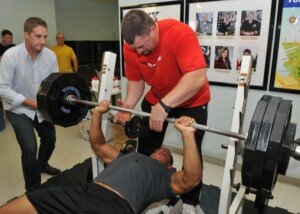
Few people do what would be called the corner bar single-arm shoulder press.
Many people may not even know what the corner bar refers to.
The corner bar is the Olympic bar that sits in the corner of a gym wall.
Sometimes there is a device on the floor in the corner, to which a person fits one end of the bar into for stability, as a pivotal point.
If the device isn’t there, the bar is jammed up into the corner anyhow.
The bar is angled out at the midpoint (about 45 degrees) between the two walls of the corner, and is typically used as a variation of a bent-over barbell row.
However, this type of setup can be used in numerous ways.
Corner Bar Single-Arm Shoulder Press Instructions
This exercise is also known as the landmine press.
One simply faces the corner (standing midway between the two walls of the corner) and picks up the bar, and using one arm, presses it above their head. The push may be preceded by a squat or lunge.
The angle of the press can range from straight up (vertical) to outward somewhat in front of the trainee.
An Olympic bar without any added weight is 45 pounds.
This will be too heavy for women to handle with one arm unless they’re already strong from lifting weights.
Thus, in this case, the not-so-fit person should use two hands, cradling the bar in both hands, both hands placed near the neck at the bottom or start of the movement.
You then extend the arms, hands rising right before the face in doing so.
Since this is a two-hand hold, the arms will be close together during the movement, and this means that there will be more triceps involvement than you may wish for if you’re seeking more of a pure shoulder workout.
However, if one-hand is too heavy, you have no choice but to first get stronger with two hands.
You can also get stronger by performing regular dumbbell and barbell shoulder presses, as well as using shoulder press machines.
Corner Bar Single-Arm Shoulder Press Variation
Another alternative for the weaker individual is to work at the one-arm version, but add a little leg thrust with the pressing.
In fact, this technique isn’t uncommon for those who are stronger and want to work with heavy weight with this exercise.
For stronger individuals, the start position (bottom of the movement) has the bar being held at shoulder level.
The hand placement may be directly above the shoulder, sitting on top of the shoulder in the rest position before the set begins.
The down-stroke, however, does not involve a rest, but rather, lowering the bar to just over the shoulder; there is no touching between reps.
The hand placement may also be (as already pointed out) a bit ahead of the trainee, depending on how close the hand is to the end of the bar, and where they are standing relative to the end of the bar.
If the hand placement is a little outward or ahead, the hand should be aligned with the outside of the shoulder, rather than the hand being aligned with the chest bone or somewhere between the chest bone and the shoulder.
You then push the weight as high as possible, straightening the arm.
If the extension of the arm goes out more horizontally than vertically, then this means that the movement is also a chest exercise, which is not what you want if you are seeking a solid shoulder exercise.
The more vertical the press, the more targeted the shoulder muscles become.
You stand in place, feet about shoulder width apart, and press the bar all the way up, then down, with the same tempo that would be used if you were pressing a dumbbell, barbell military style or the handles of a machine.
As the burn kicks in towards the end of the set, the trainee can add a little thrust with their legs (going up on their toes), or, they can assist with their other hand.
No twisting with the corner bar single-arm shoulder press…
At no time should you rotate or twist at the waist while performing this exercise. This includes while using the free hand to assist.
The torso must remain immobile and facing the pivotal point of the other end of the bar at all times.
Otherwise, to twist while lifting with one arm will put you at risk of straining the back muscles—and the pain can be debilitating and take a few weeks to heal.
If the bar alone is not heavy enough to induce failure or near-failure in 8-12 reps (the formula for maximizing hypertrophy), then you can add plates to the bar.
A variation of the corner bar single-arm shoulder press is to perform this exercise while seated.
Again, torso should be squarely facing the corner, the seat midway between the two walls of the corner.
The seated position takes stress off the lower back.
However, this position also forces more of an isolation of the shoulder muscles; this exercise, done seated, is harder than when done standing.
 Lorra Garrick has been covering medical, fitness and cybersecurity topics for many years, having written thousands of articles for print magazines and websites, including as a ghostwriter. She’s also a former ACE-certified personal trainer.
Lorra Garrick has been covering medical, fitness and cybersecurity topics for many years, having written thousands of articles for print magazines and websites, including as a ghostwriter. She’s also a former ACE-certified personal trainer.
.









































